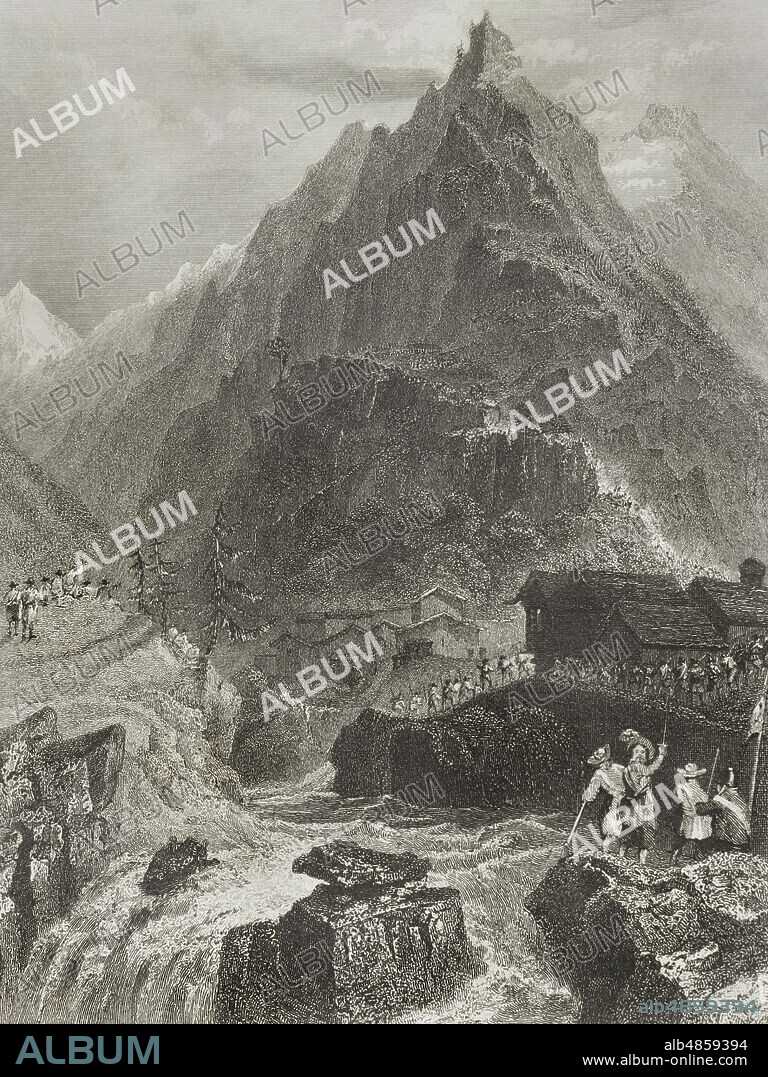alb4859394
ANTONIO ROCA SALLENT (1813-1864). SPANISH ENGRAVER.. Persecution of the Waldensians (1540-1570). The Waldensians are followers of an ecclesiastical tradition that began as an ascetic movement within Western Christianity before the Reformation. In 1215 they were declared heretics. Pope Innocent III offered them the chance to return to the Church. Many of them did so, the so-called "Poor Catholics". Those who did not accept were subjected to great persecution. In the 16th century, the Waldensians were absorbed into the Protestant movement, under the influence of the early Swiss reformer Heinrich Bullinger. They were aligned with Protestantism. With the Resolutions of Chanforan on 12 September 1532, they formally became part of the Calvinist tradition. Pradeltorno attack, 16 February 1561. The lord of Trinity stormed from three different points. It was a natural stronghold of very difficult access, at the top of the Angrogna Valley, which became the center of the Waldensian resistance. Village of Balziglia, Massello, in Piedmont. The defeated Waldensians had to flee to Switzerland and Germany. Engraving by A. Roca. Historia de las persecuciones políticas y religiosas en Europa (History of political and religious persecutions in Europe). Volume I. Published in Barcelona, 1863.

|
Zu einem anderen Lightbox hinzufügen |
|
Zu einem anderen Lightbox hinzufügen |



Haben Sie bereits ein Konto? Anmelden
Sie haben kein Konto? Registrieren
Dieses Bild kaufen.
Nutzung auswählen:

Untertitel:
Siehe automatische Übersetzung
Persecution of the Waldensians (1540-1570). The Waldensians are followers of an ecclesiastical tradition that began as an ascetic movement within Western Christianity before the Reformation. In 1215 they were declared heretics. Pope Innocent III offered them the chance to return to the Church. Many of them did so, the so-called "Poor Catholics". Those who did not accept were subjected to great persecution. In the 16th century, the Waldensians were absorbed into the Protestant movement, under the influence of the early Swiss reformer Heinrich Bullinger. They were aligned with Protestantism. With the Resolutions of Chanforan on 12 September 1532, they formally became part of the Calvinist tradition. Pradeltorno attack, 16 February 1561. The lord of Trinity stormed from three different points. It was a natural stronghold of very difficult access, at the top of the Angrogna Valley, which became the center of the Waldensian resistance. Village of Balziglia, Massello, in Piedmont. The defeated Waldensians had to flee to Switzerland and Germany. Engraving by A. Roca. Historia de las persecuciones políticas y religiosas en Europa (History of political and religious persecutions in Europe). Volume I. Published in Barcelona, 1863.
Standort:
Privatsammlung
Bildnachweis:
Album / Prisma
Freigaben (Releases):
Model: Nein - Eigentum: Nein
Rechtefragen?
Rechtefragen?
Bildgröße:
3189 x 4250 px | 38.8 MB
Druckgröße:
27.0 x 36.0 cm | 10.6 x 14.2 in (300 dpi)
Schlüsselwörter:
16. JAHRHUNDERT • 16. JH. • ALPEN • ANGRIFF • ANTONIO ROCA SALLENT (1813-1864). SPANISH ENGRAVER. • ARMEE • ARMEE: SOLDAT • ARMY • BALZIGLIA • BERG • CHRISTENTUM • EUROPA • EUROPAEER (F M) • EUROPAEER • EUROPÄER (F M) • EUROPÄER • EUROPÄISCH • FELSEN • GEISTLICHER • GEISTLICHKEIT • GESCHICHTE • GESTEIN • GRAVUR • HEER • ITALIEN • KLERIKER • PIEDMONT • PRIVATSAMMLUNG • PROTESTANT • PROTESTANTISCH • PROTESTANTISMUS • RELIGION • SOLD • SOLDAT • SOLDATEN • STEIN • STICH (KUNST) • STURM (MILITAERISCH) • TRUPPEN • UEBERFALL • VOLKSARMIST • WALDENSER • ZEITGESCHICHTE
 Pinterest
Pinterest Twitter
Twitter Facebook
Facebook Link kopieren
Link kopieren Email
Email
